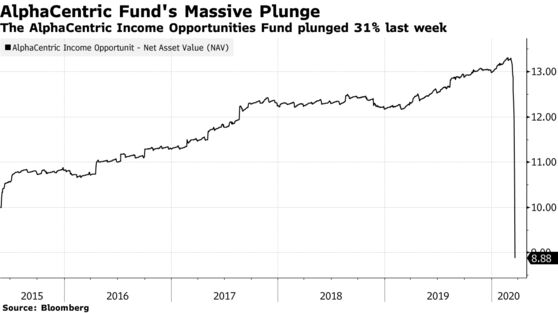It looks like you're new here. If you want to get involved, click one of these buttons!
A crisis in credit markets deepened on Sunday as a cluster of funds that own mortgage bonds sought to sell billions in assets to meet investor redemptions, sparking pleas for government intervention.
The sales included at least $1.25 billion of securities being listed by the AlphaCentric Income Opportunities Fund on Sunday, according to people with knowledge of the sales. It sought buyers for a swath of bonds backed primarily by private-label mortgages as it sought to raise cash, said the people, who asked not to be identified discussing the private offerings. The fund plunged 17% on Friday, bringing its total decline for the week to 31%.
“The coronavirus has resulted in severe market dislocations and liquidity issues for most segments of the bond market,” AlphaCentric’s Jerry Szilagyi said in an emailed statement on Sunday. “The Fund is not immune to these dislocations” and “like many other funds, is moving expeditiously to address the unprecedented market conditions.”
The best way to obtain favorable prices is to offer a wider range of securities for bid, Szilagyi said. He declined to discuss the amount of securities the fund put up for sale.

By Loeffler's own admission, her holdings are not in a blind trust. She is routinely told what she owns (independent of whether it is in a trust).Mark - This article https://www.nytimes.com/2020/03/20/us/politics/kelly-loeffler-richard-burr-insider-trading.html?searchResultPosition=1 refers to Sen. Feinstein's office stating that her investments are in a blind trust. (There's a link.) Not sure about a link from Sen. Loeffler. Both senators are married to wealthy investors.
Thanks for that chart @wxman123 . I, like many, am trying to figure out when to move in a substantial way to reenter the market of stocks. This history lesson from 1917 to 1918 is helpful in that regard. It suggests that at some point living with a pandemic becomes the new normal and gets priced into the market. So far I have been nibbling enough to keep the stock % in my portfolio from dropping significantly, but nothing more. I am currently inclined to wait at least until fall to see if there is a new surge in covid-19 cases then before moving back into stocks in a more substantial way.....assuming the initial surge peaks within the next several weeks. That will also provide time to get a sense for peoples willingness to restrict their interactions over an extended period of time as a vaccine is probably not going to be available any time soon.I saw a pretty interesting chart the other day comparing covid-19 with the Spanish flu in terms of market reaction. Nearly identical to this point. With the Spanish flu the market recovered rapidly and well before the virus subsided. If we follow the same pattern now is the time to buy. We may not follow the 2008 model, which was a financial crisis.
https://www.marketwatch.com/story/market-behavior-a-century-ago-suggests-the-worst-could-be-over-for-stocks-if-not-for-the-coronavirus-pandemic-2020-03-19
© 2015 Mutual Fund Observer. All rights reserved.
© 2015 Mutual Fund Observer. All rights reserved. Powered by Vanilla